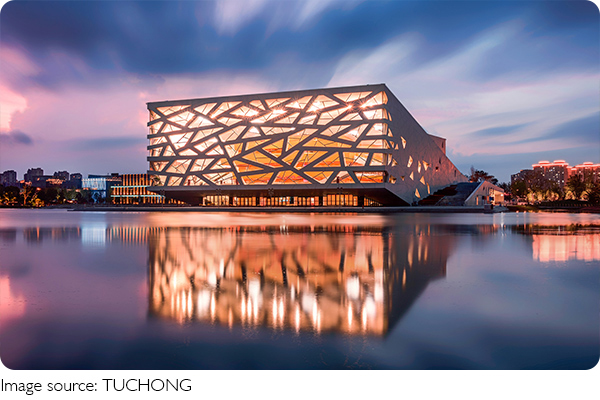Geometric Industrial Futures

Have you ever walked past a building and thought, "This looks like it came straight out of a sci-fi movie"? That's the magic of futuristic architecture.
As we move further into the 21st century, we’ve noticed a powerful shift in how buildings are designed—not just to serve functional needs, but to stir our imagination.
At the core of this transformation is a fascinating fusion: geometric abstraction and industrial design. So today, let’s explore how this mix is not only changing skylines but also shaping how we experience the built world.
What Is Geometric Abstraction in Architecture?
Geometric abstraction may sound complex, but at its heart, it’s about using pure shapes—like circles, squares, and lines—to create beauty. In architecture, this means moving away from traditional forms like pitched roofs or ornate facades, and instead embracing sharp angles, clean planes, and repeating patterns. We see this in cube-like homes, triangular windows, or rhythmic structures made of repeating modules. It’s minimalistic, but bold. It's abstract, but expressive.
For example, buildings like Zaha Hadid’s Heydar Aliyev Center in Azerbaijan blur the boundaries between form and fluidity, while still relying on the geometric principles that give them structure. These buildings don’t just serve a purpose—they tell a visual story.
How Industrial Design Shapes Our Cities
Industrial design brings a totally different flavor to architecture. It’s all about utility, mass production, and user experience. Think modular panels, lightweight materials, metal exteriors, and smart integration of technology. When we blend industrial design with architectural vision, we end up with buildings that are not only beautiful but also efficient and sustainable.
Take the Apple Park campus in California as an example. Its circular form follows geometric clarity, but its construction and interior details—glass panels, ventilation, sustainable energy systems—are all rooted in industrial precision. It’s a space designed for people, optimized through machines, and shaped by a vision of the future.

Why This Fusion Matters
Now you may wonder, why is this blend of abstraction and industry so important? The answer lies in balance. Geometric abstraction gives us artistic freedom—it allows us to imagine buildings as sculptures. Industrial design, on the other hand, keeps things grounded—focused on durability, usability, and innovation.
When we combine both, we’re not just making cool buildings. We’re creating homes that adapt to climate, offices that inspire creativity, and public spaces that welcome everyone. The futuristic design isn’t about just looking good—it’s about feeling right, functioning well, and sparking curiosity.
Examples Around the World
Across the globe, we can already see examples of this fusion in action. From the Beijing Daxing International Airport’s starfish-like design to the Luma Arles Tower in France by Frank Gehry, futuristic architecture is making a strong mark. Even temporary pavilions at design expos now test daring forms with sustainable materials.
We’ve also noticed a growing interest in 3D printing buildings, using geometric algorithms to reduce waste and maximize space. This is no longer fantasy—it’s reality unfolding, one structure at a time.
What’s Next for Us?
Looking ahead, we expect even more harmony between form and function. Artificial intelligence, sustainable materials, and digital fabrication will play key roles in shaping our future cities. We’ll see buildings that adjust to weather, respond to the movement of people, and blend seamlessly into natural environments—all while expressing abstract visual language.
As designers and thinkers, we should ask: how can we create spaces that are more than shelters? How can they elevate our lives, emotions, and even dreams? The future of architecture lies in this question.
Let’s Imagine Together
Lykkers, have you ever sketched your dream home or imagined the city of tomorrow? Let’s start talking about how our surroundings can shape our future. Architecture isn't just for architects—it’s for all of us. As we move into an era of smarter, more poetic buildings, we hope to walk through cities that feel like a blend of art, science, and soul.
If you’ve seen any buildings that made you stop and wonder, tell us! Let’s explore the future together—one shape, one idea, and one story at a time.
How This Famous Architect Revolutionized The Way Architects Design | Architectural Digest
Video by Architectural Digest
-
 Vase Timeless BeautyDiscover the Secret World of Luxurious Antique and Modern Vases – A Timeless Collection for Every Style!
Vase Timeless BeautyDiscover the Secret World of Luxurious Antique and Modern Vases – A Timeless Collection for Every Style! -
 Driftwood ArtistryUncover the Hidden Beauty of Driftwood Sculptures—You Won’t Believe What These Artists Can Create from Nature’s Castaways!
Driftwood ArtistryUncover the Hidden Beauty of Driftwood Sculptures—You Won’t Believe What These Artists Can Create from Nature’s Castaways! -
 Can Flowers Shape You?Want to grow your character? Flower arranging isn’t just about beauty—it's a transformative journey! Ready to bloom?
Can Flowers Shape You?Want to grow your character? Flower arranging isn’t just about beauty—it's a transformative journey! Ready to bloom?